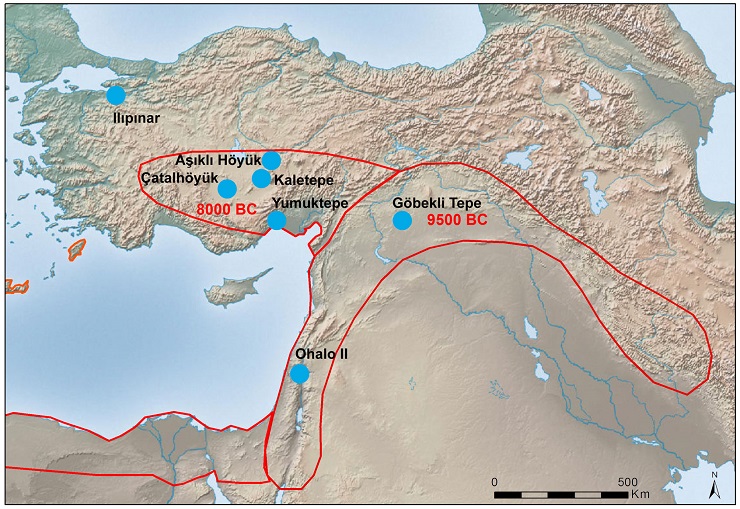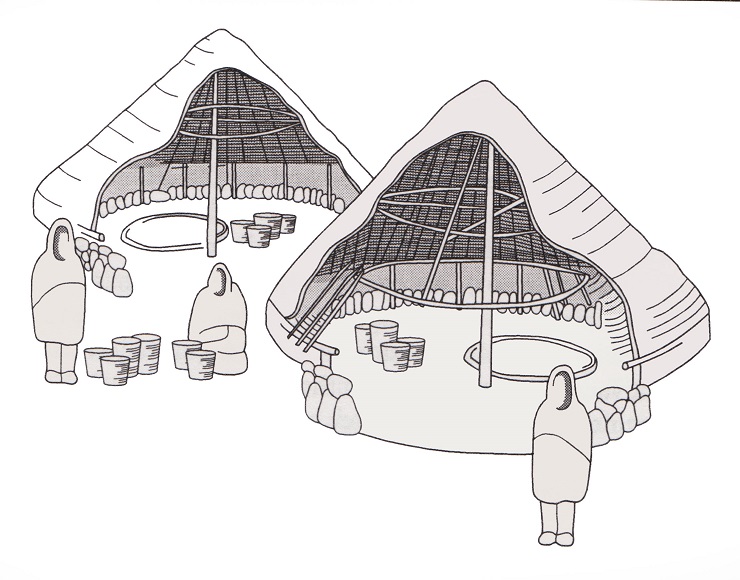The Near East region attracts scientific interest mainly on the grounds that by implementing natural science analyses the presence of the wild forms of cereals, legumes and later-on of domesticated animal species was confirmed for a past period of a few tens of thousands of years.
 |
|
The oldest Neolithic sites are located in the Near East. Due to the constant social tensions and the wars in the key Syro-Levant area, for example, it is not currently possible to carry out the much-needed revision research using modern methods. The diagram depicts the locations that are mentioned in the text. |
The geographic area that has a shape reminiscent of an inverted crescent moon – and which therefore is also referred to as the Fertile Crescent - can be delimited by the areas of Levant (in the Eastern Mediterranean, comprising today’s Sinai Peninsula in Egypt, the land of Israel, the Palestinian Authority, Lebanon, Jordan and Syria), Upper Mesopotamia (formerly called Southeast Anatolia - identified today as SE Turkey), Middle and Lower Mesopotamia (now comprising the present-day Iran and Iraq and the lower basins of the Tigris and the Euphrates Rivers). It therefore represents a vast and raggedy hodgepodge of landscape types running from the sea-coast and the plains to the area of the Zagros Mountains that are now located in today’s Iran.
Already at the end of the Early Stone Age (the Epipalaeolithic era) more than 20,000 years ago, the grain from wild forms of cereals - barley and some variants of wheat - were demonstrably being processed using stone grinding tools at the site designated as Ohalo II, located in the present-day State of Israel, which verifies their routine usage for subsistence. Plant components also constituted part of the diet during the subsequent period, which we refer to as the Kebaran complex (18,000 – 12,500 BC). Different size groups of hunter-gatherers of this cultural complex inhabited a relatively elongated area corresponding roughly to the left half of the Fertile Crescent. The evidence of processing plant foods is represented by stone mortar pads, beaters and mortars. A slightly larger space was occupied by the subsequent Natufien complex (12,500 – 9,800 BC), in the earlier stage of which it is possible to document several long-term populated areas, including the planned development. At that time a wide range of plants and animals were utilised and later demonstrably bred and domesticated. An analysis of the human remains, especially of teeth, also confirms the consumption of a much higher proportion of vegetable products than during the previous period. In their later stages, however, the number of settlement areas dwindled, and while there is also evidence of increasing mobility this is inconsistent with any concept of linear progress.
 |
| In regard to their layout and the technologies utilised the dwelling units dating from the PPNA Pre-Pottery Neolithic period, built of daubed wattle and reed, copy the Natufien hunter-gatherers. They appear in large numbers on settlements, forming spatial clusters, while the surrounding material findings suggest the long-term use of some of these sites. Barker 2006, p. 133, Fig. 4.10 (adapted). |
In the northern region, alongside the middle flows of the Euphrates and the Tigris Rivers, typically around 100-300 people lived in the yet-known major settlements. The overall population growth also probably caused a fundamental change to the social structure, which is one hypothesis that takes into account the fact that the process of neolithisation also occurred on different continents. Simply stated, this indicates that the larger settlement units must have been organised in some manner and it is therefore possible to consider the existence of individuals or groups who already at that time enjoyed an exceptional social status. Another indication of a more complex societal structure is indicated by the exclusive products that were imported from the neighbouring regions.
Permanent settlements do not appear more frequently until the middle of the 10th millennium BC. Towards the end of this millennium the first monumental stone buildings were constructed at locations in Tel es-Sultan (Jericho, Jordan) and in Göbekli Tepe (Turkey). Only recently has evidence of the cultivation of later crops and the raising of goats and sheep and later also cattle and pigs been uncovered at these settlements. These findings, however, still bear none of the typical signs of domestication.
 |
| Separate longhouses divided into several interior spaces do not represent a Neolithic innovation in Central Europe. There is documentation in SE Turkey of buildings dating back to the PPNB pre-pottery period that are more than 10 m long which combine a spherical structure with stone plinths as is shown in this image showing the reconstruction of a longhouse in accordance with the imaginings of Turkish scholars. In the Syro-Levant area mainly adobe bricks were utilised and the houses were traditionally built in close proximity to each other. Özdoğan et al. 2011, p. 124, Fig. 7B (adapted). |
Anatolia – today constituting a part of Turkey’s territory - represents an interesting historical item in regard to researching the Near Eastern Neolithic. During both the 9th and the 8th millennium BC there were intensive communication links between the southeastern and the central territories of Turkey and the Syro-Levant. This is a stage of the Neolithic where it is already possible to encounter stratified (and therefore credible) findings of domesticated plants and animals. This stage of the Pre-Pottery Neolithic, currently referred to as PPNB, represents the absolute culmination-point of its previous development, in terms of contacts, subsistence activities, technologies and habitual activities. We know that at the end of this epoch there was a wide range of mega-settlements covering areas of more than 10 hectares, comprising rectangular houses that were divided into several room areas. At the end of 8,000 BC, however, the agglomerations were either simply abandoned or their size was radically reduced. This may have resulted from changes to the natural environment, from resource depletion, from a population explosion or a change to the subsistence strategy, including refocusing on some of the aspects of seasonal pastoralism. The quantity of imports was radically reduced and by-and-large the burial rite also changed. However, this was also a period that has provided us with plentiful evidence regarding settlements in the more western parts of Anatolia, and there are also areas in which the density of Neolithic sites increased rapidly. This is a period that has crucial significance for our European continent, although, as we will see later, the causes and consequences of these changes are still in dispute. At present, the concept of population movement from Anatolia to the Balkans having taken place between the end of the 7th millennium BC and the beginning of the 6th millennium BC seem prevalent, especially amongst Turkish scholars.
Based on the scientific analysis of plant remains dating back to the different periods mentioned above, several generations of researchers were trying to determine the origin, the place of origin and the progress of the cultivation and the domestication of cereals. It seems that so far, however, based on the current knowledge, we really need to take into account several foci and also the different causes of the Neolithic that emanated from the Near East.
|
|
| The basic building material in the Near East were adobe bricks. Their production is captured in this image from modern Burkina Faso. Photo by Eliška Podgorná 2014. |
Want to learn more?
- Barker, G. 2006: The Agricultural Revolution in Prehistory: Why did Foragers become Farmers? Oxford: Oxford University Press, 125.
- Colledge, S. – Conolly, J. 2010: Reassessing the evidence for the cultivation of wild crops during the Younger Dryas at Tell Abu Hureyra, Syria. Environmental Archaeology. The Journal of Human Palaeoecology 15/2, 124-138.
- Nadel, D. – Piperno, D. R. – Holst, I. – Snir, A. – Weiss, E. 2012: New evidence for the processing of wild cereal grains at Ohalo II, a 23 000-year old campsite on the shore of the Sea of Galilee, Israel. Antiquity 86, 990–1003.
- Özdoğan, M. – Başgelen, N. 1999: Neolithic in Turkey, the Cradle of Civilisation. Istanbul: Archaeology & Art Publications, 193-202.
- Potts, D. T. ed. 2012: A Companion to the Archaeology of the Ancient Near East. Blackwell Companions to the Ancient World. Volume 1. Wiley-Blackwell.
- Schmidt, K. 2007: Sie bauten die ersten Tempel. Das rätselhafte Heiligtum der Steinzeitjäger. München: Verlag C. H. Beck.
- Simmons, A. H. 2010: The Neolithic Revolution in the Near East: Transforming the Human Landscape. Tucson: University of Arizona Press, 184-194.
- Wright, K. I. 1994: Ground – stone tools and hunter – gatherer subsistence in southwest Asia: implications for the transition to farming. American Antiquity 59, 238–263.
 Archeologické 3D virtuální muzeum
Archeologické 3D virtuální muzeum

.jpg)
